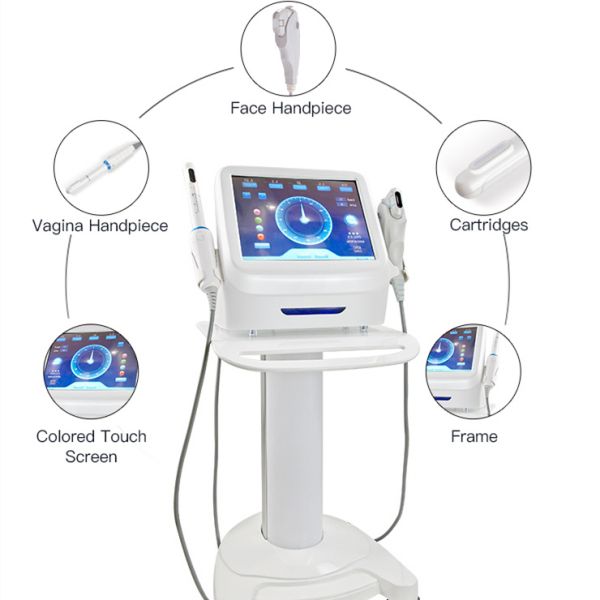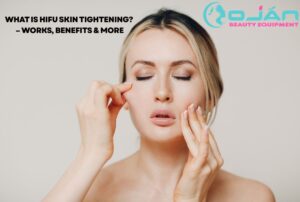
What Is HIFU Skin Tightening? – Works, Benefits & More
This technology has been utilized for medical treatments over several years, including tumor ablation and various other therapeutic applications. On the contrary, HIFU’s use in cosmetics has drastically altered the theatrical and anti-aging treatments whereby it acts as a safe and efficacious way to cause tightened and rejuvenated skin. This article discusses What Is HIFU Skin Tightening, how it works, its benefits, and others.
Table of Contents
ToggleWhat Is HIFU Skin Tightening Overview

The beauty and medical aesthetics field has embraced High-Intensity Focused Ultrasound (HIFU) as a sophisticated non-invasive treatment for tightening skin. The treatment targets deeper skin layers with concentrated ultrasound energy which triggers collagen production and achieves a natural lift effect. HIFU stands out from surgical facelifts because it eliminates the need for surgical incisions and anesthesia as well as the extended recovery time required after surgery.
How Does HIFU Skin Tightening Work?
With ultrasound energy, HIFU heats the deeper layers of the skin with a focus on the Superficial Musculoaponeurotic System (SMAS), which, just like in surgical facelifts, is the layer targeted. The energy passes underneath the skin without harming the surface to reach depths of 1.5mm, 3mm, and 4.5mm, according to the area to be treated.
The delivery of ultrasound energy causes a controlled thermal injury that opens the body’s healing process with subsequent stimulation of collagen and elastin production, which are the proteins responsible for skin firmness and elasticity. In time, the skin tightens and lifts while the wrinkles and sagging decrease.
The quality of the skin keeps improving for many months post-treatment with visible results arising in a few weeks and optimal results in three to six months. It has deep penetration into the skin compared to other skin tightening methods, driving long-term rejuvenating effects, which is a significant advantage of HIFU.
Benefits of HIFU Skin Tightening
HIFU provides several advantages for individuals looking to enhance their skin’s appearance without undergoing invasive procedures. Some key benefits include:
- Non-invasive and non-surgical: HIFU does not require cuts, stitches, or anesthesia, making it a safer alternative to traditional facelifts.
- Collagen production: The treatment promotes the natural regeneration of collagen, which is essential for youthful, firm skin.
- Long-lasting results: Many individuals experience improvements that last for up to 18 months after a single session.
- Minimal downtime: Unlike surgery, HIFU requires no recovery period, allowing patients to return to their daily activities immediately.
- Natural-looking results: Since the process works by stimulating the body’s healing mechanisms, the results appear gradually and naturally.
- Safe for all skin types: HIFU is effective for various skin tones and does not involve UV light or laser energy that can cause pigmentation issues.
Who Is a Suitable Candidate for HIFU?

HIFU is an excellent option for individuals who want to address mild to moderate skin laxity without undergoing surgery. It is particularly beneficial for people who:
- Are between 30 and 60 years old and experiencing early signs of aging.
- Have mild to moderate skin sagging in areas such as the face, neck, or décolletage.
- Want to improve the appearance of fine lines and wrinkles.
- Prefer non-invasive treatments over surgical procedures.
- Are in good overall health and have realistic expectations.
However, HIFU may not be suitable for individuals with severe skin laxity, open wounds, infections, or those who have metal implants in the treatment area. Consulting with a professional can help determine if HIFU is the right treatment.
What to Expect During a HIFU Treatment?
A typical HIFU session starts with a consultation where a specialist assesses the patient’s skin condition and discusses treatment goals. The procedure itself involves the following steps:
- Cleansing: The treatment area is cleaned to remove any dirt, oil, or makeup.
- Application of ultrasound gel: A gel is applied to ensure proper transmission of ultrasound waves.
- HIFU device application: The practitioner moves the device over the skin, delivering focused ultrasound energy at varying depths.
- Sensation: Patients may feel warmth or tingling, but discomfort is usually minimal.
- Completion: The session lasts between 30 to 90 minutes, depending on the treated area.
After the treatment, mild redness or swelling may occur, but these effects subside within a few hours.
Side Effects and Risks of HIFU Skin Tightening
HIFU is a safe procedure, but some temporary side effects may include:
- Redness or swelling immediately after treatment.
- Mild discomfort or tingling sensations during the procedure.
- Temporary numbness or slight bruising in treated areas.
Serious complications are rare, and the risk of adverse effects is significantly lower than with surgical alternatives. Following post-treatment guidelines can help minimize discomfort and ensure a smooth recovery.
How Long Do HIFU Results Last?
The longevity of HIFU results varies from person to person. Most individuals notice visible improvements within a few weeks, with full effects developing over three to six months. Results can last up to 18 months, depending on factors such as:
- Age and skin condition.
- Lifestyle habits, including sun exposure and skincare routine.
- The number of sessions received.
To maintain the benefits, some individuals choose to undergo touch-up sessions annually.
HIFU vs Other Skin Tightening Treatments
HIFU is often compared to other skin tightening methods such as radiofrequency (RF) and surgical facelifts. Below is a comparison:
- HIFU vs RF: While both stimulate collagen, HIFU penetrates deeper, making it more effective for skin lifting.
- HIFU vs Surgical facelift: Surgery provides dramatic results but requires downtime and carries risks. HIFU is a safer alternative with gradual, natural improvements.
- HIFU vs Microneedling: Microneedling works on the skin’s surface, whereas HIFU reaches deeper layers for long-term tightening.
Aftercare and Post-Treatment Tips
To maximize the results of HIFU, consider the following aftercare tips:
- Avoid excessive sun exposure and apply sunscreen daily.
- Stay hydrated to support collagen production.
- Use gentle skincare products to avoid irritation.
- Avoid extreme heat (saunas, hot showers) for a few days.
- Follow up with touch-up treatments as recommended by a specialist.
Frequently Asked Questions About HIFU Skin Tightening
Does HIFU hurt?
Most of the patients feel a bit of discomfort but generally tolerate it. Some describe it as like a warming feeling or slight tingling sensation.
How many sessions are required?
Usually, one session is enough, but for some, multiple treatments might be necessary for optimum results.
HIFU instead of a facelift?
Although providing significant lifting effects, it cannot substitute surgical facelifts in cases of severe sagging.
How much do they cost?
Cost varies from location to location and areas to treat but will generally be less than any surgical alternative.
Conclusion
Skin tightness technology through HIFU is a new-age, non-invasive treatment from which every person can get firmer skin during old-age. HIFU triggers new collagen production down in the UI dermis for permanent results with short downtime. HIFU Skin Tightening is a non-surgical alternative for early age-scoring treatment or improvement of facial contours. Consultation with an expert will help determine one’s considerations regarding HIFU Skin Tightening treatment.
Deep stimulation of collagen growth into the skin for long-lasting but minimal downtime after treatment is what current non-invasive treatment, like HIFU skin tightening, achieves firmer, younger-looking skin. Whether one is after the early signs of aging or improving the contours of the face, it is surely an effective and safe alternative to surgery. Pro therapist can advise best if it is really necessary for you to get such treatment.
